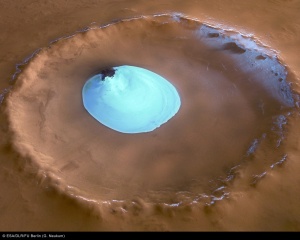
Home
Why on Mars?
Principle
Hardware
Animations
Links
People
Partners
Why an AFM on Mars ?
Clues to the geologic history and biological potential of the martian arctic shall be uncovered, by analyzing soil and water ice samples (scooped by the robotic arm).
Three instruments will be located in a box called MECA (Microscopy, Electrochemistry and Conductivity Analyzer). There are four wet chemical reaction cells, an optical microscope and an Atomic Force Microscope (AFM). An associated experiment (thermal and electrical conductivity probe) is located on the robot arm on the Lander which is used to scoop Martian soil and water ice samples from the surface for processing by the MECA instruments.
 Mars crater with water ice
Mars crater with water ice
click for a larger image (419k)
MECA characterizes the soil of Mars. By dissolving small amounts of soil in water, MECA determines the pH, the abundance of minerals such as magnesium and sodium cations or chloride, bromide and sulfate anions, as well as dissolved oxygen and carbon dioxide. Looking through a microscope, MECA examines the soil grains to help determine their origin and mineralogy. Needles stuck into the soil determine the water and ice content, and the ability of both heat and water vapor to penetrate the soil.
MECA will determine the sizes and shapes of particles and will perform experiments to learn about adhesion, abrasion, and the electrostatic behavior of particles on Mars. The optical microscope can image particles in the range from about 1 millimeter down to 1 micrometer (1/1'000 millimeter). The AFM has a much higher resolution which ranges from 10 micrometers down to 10 nanometers (1/100'000 millimeter). This new method allows scientists to have a much closer look at Martian soil and exciting new insights can be expected.